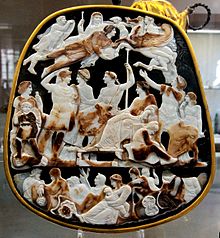Augustan and Julio-Claudian art
Suetonius recalls that: Rome was not up to the grandeur of the Empire and was exposed to floods and fires, but he embellished it to such an extent that he rightly boasted of leaving the city he had found made of bricks of marble.
The political evolution of Augustus was promptly reflected in official art, as evidenced by the series of imperial portraits.
Typical features of his portraits are the steady eyes, the straight nose, the rather hollowed face, the well-pronounced cheekbones, the thin mouth, and a lock of hair "with a pincer" on the right side of the forehead.
The portrait of Octavian at the Capitoline Museums shows him as he was in the period between 35 and 30 BC, when Augustus had not yet assumed the imperial titles and was still taken by the struggle for political supremacy.
These show an expression of proud reserve, a disposition Augustus demonstrated in his Res Gestae Divi Augusti.
The general Italic approach is mixed with neo-Attic reliefs and a frieze in the style of Pergamon; all combined without precise logical relationships between architectural parts and decorations.
At the end of the reign of Augustus, there were detailed garden frescoes painted in the large room of the Villa of Livia.
The painting of these types of gardens derives from eastern influence, with lower quality examples found in some tombs of the Gabbari necropolis.
The most famous hall of the Villa of the Mysteries also likely dates back to the time of Augustus, where copies of Greek paintings and Roman insertions are mixed.
[citation needed] Fine Roman metalwork largely followed Greek artists such as Pasiteles, who also wrote several books on chasing.
In the period of Augustus, this art had a remarkable technical and artistic level, demonstrated by the numerous silver pieces found in various parts of the Empire, notably the Hildesheim Treasure.
The great development from which the western provinces benefited in this period coincided with the birth and establishment of the characteristics of provincial art.







